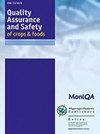Effects of chitosan treatment on the texture parameters of okra fruit (Abelmoschus esculentus L. Moench)
IF 5.3
3区 农林科学
Q1 FOOD SCIENCE & TECHNOLOGY
引用次数: 4
Abstract
In recent years, due to its medicinal properties and reputation as a healthy vegetable, consumption of okra (Abelmoschus esculentus L.) has considerably increased in China. In this study, texture parameters (hardness, springiness, cohesiveness, gumminess, chewiness, and resilience) of okra fruit subjected to chitosan (CTS) treatment and control were determined during storage. The changing pattern of texture properties and the differences between three different cultivars (Kariba, ACF, and Xianzhi) were observed at three testing stages (0, 15, and 30 days of storage), which indicated a significant cultivar-dependent pattern. The hardness, cohesiveness, gumminess, chewiness, and resilience of the fruit, both in the 1% CTS treatment group and the control group, declined along with storage time. The small fruits (length < 10 cm) scored relatively low in most of the texture parameters and rate of intact when compared with large (length ≥ 15 cm) and medium-sized fruits (10 ≤ length < 15 cm). There was a significant, positive correlation between firmness, cohesiveness, gumminess, chewiness, and resilience. Our results revealed that a 1% N, O-carboxymethyl CTS solution can effectively delay softening and maintain the texture profile of the okra fruit. In the case of Kariba (A) and Xianzhi (C), the medium-sized fruits showed better storage resistance, while the large fruit of ACF (B) showed the best storage resistance.壳聚糖处理对秋葵果实结构参数的影响
近年来,由于其药用价值和健康蔬菜的声誉,秋葵(Abelmoschus esculentus L.)在中国的消费量大幅增加。本研究测定了壳聚糖(CTS)处理和对照秋葵果实在贮藏过程中的质地参数(硬度、弹性、黏结性、粘性、咀嚼性和回弹性)。在贮藏0、15和30 d的3个试验阶段,观察了Kariba、ACF和仙芝3个不同品种间织质特性的变化规律和差异,结果显示出明显的品种依赖性。1% CTS处理组和对照组果实的硬度、黏结性、胶性、嚼劲和回弹性均随贮藏时间的延长而下降。与大水果(长度≥15 cm)和中等水果(10≤长度< 15 cm)相比,小水果(长度< 10 cm)在大多数质地参数和完好率上得分相对较低。在硬度、内聚性、胶性、咀嚼性和弹性之间存在显著的正相关。结果表明,1%的N, o -羧甲基CTS溶液可以有效延缓秋葵果实的软化,并保持其质地轮廓。在Kariba (A)和Xianzhi (C)中,中等果实表现出较好的贮藏抗性,而ACF (B)的大果实表现出最好的贮藏抗性。
本文章由计算机程序翻译,如有差异,请以英文原文为准。
求助全文
约1分钟内获得全文
求助全文
来源期刊

Quality Assurance and Safety of Crops & Foods
FOOD SCIENCE & TECHNOLOGY-
CiteScore
4.60
自引率
7.50%
发文量
61
审稿时长
1 months
期刊介绍:
''Quality Assurance and Safety of Crops & Foods'' is an international peer-reviewed journal publishing research and review papers associated with the quality and safety of food and food sources including cereals, grains, oilseeds, fruits, root crops and animal sources. It targets both primary materials and their conversion to human foods. There is a strong focus on the development and application of new analytical tools and their potential for quality assessment, assurance, control and safety. The scope includes issues of risk assessment, traceability, authenticity, food security and socio-economic impacts. Manuscripts presenting novel data and information that are likely to significantly contribute to scientific knowledge in areas of food quality and safety will be considered.
''Quality Assurance and Safety of Crops & Foods'' provides a forum for all those working in the specialist field of food quality and safety to report on the progress and outcomes of their research.
 求助内容:
求助内容: 应助结果提醒方式:
应助结果提醒方式:


